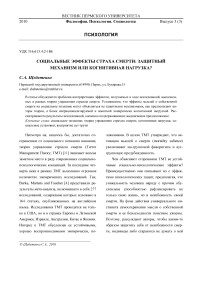Социальные эффекты страха смерти: защитный механизм или когнитивная нагрузка?
Автор: Щебетенко Сергей Александрович
Журнал: Вестник Пермского университета. Философия. Психология. Социология @fsf-vestnik
Рубрика: Психология
Статья в выпуске: 3 (3), 2010 года.
Бесплатный доступ
В статье обсуждается проблема интерпретации эффектов, получаемых в ходе исследований, выполненных в рамках теории управления страхом смерти. Установлено, что эффекты мыслей о собственной смерти на социальное познание могут объясняться не защитными механизмами, как предполагают авторы теории, а более операционализируемой и понятной эмпирически когнитивной нагрузкой. Рассматриваются результаты исследований, косвенно поддерживающих выдвигаемое предположение
Социальное познание, теория управления страхом смерти, когнитивная нагрузка, социальные установки, восприятие аут-групп
Короткий адрес: https://sciup.org/147202725
IDR: 147202725
Список литературы Социальные эффекты страха смерти: защитный механизм или когнитивная нагрузка?
- Щебетенко С.А. Восприятие иммигрантов россиянами: эффекты когнитивной нагрузки, стереотипности и черт личности//Психологический журнал. 2010. Т. 31. № 2. С. 28-38.
- Arndt J., Cook, A., Goldenberg J.L., & Cox C.R. Cancer and the threat of death: The cognitive dynamics of death-thought suppression and its impact on behavioral health intentions//Journal of Personality and Social Psychology. 2007. №. 92. Р. 12-29.
- Arndt J., Greenberg J., Pyszczynski T., & Solomon S. Subliminal exposure to death-related stimuli increases defense of the cultural worldview//Psychological Science. 1997. № 8. Р. 379-385.
- Burke B.L., Martens A., & Faucher E.H. Two decades of Terror Management Theory: A meta-analysis of mortality salience research//Personality and Social Psychology Review. 2010.№ 14. Р. 155-195.
- Burris C.T., & Rempel J.K. It's the end of the world as we know it: Threat and the spatial-symbolic self//Journal of Personality and Social Psychology. 2004. № 86. Р. 19-42.
- Devine P. G. Stereotypes and prejudice: Their automatic and controlled components//Journal of Personality and Social Psychology. 1989. №56. Р. 5-18.
- Fazio R. H., Jackson J. R., Dunton B. C, & Williams C. J. Variability in automatic activation as an unobtrusive measure of racial attitudes: A bona fide pipeline?//Journal of Personality and Social Psychology. 1995. № 69. Р. 1013-1027.
- Florian V., & Mikulincer M. Fear of death and the judgment of social transgressions: A multidimensional test of terror management theory//Journal of Personality and Social Psychology. 1997. № 73. Р. 369-380.
- Florian V., & Mikulincer M. Terror management in childhood: Does death conceptualization moderate the effects of mortality salience on acceptance of similar and different others?//Personality and Social Psychology Bulletin. 1998. № 24. Р.1104-1112.
- Gilbert D. T., & Hixon J. G. The trouble of thinking: Activation and application of stereotypic beliefs//Journal of Personality and Social Psychology. 1991. №60. Р. 509-517.
- Greenberg J., Pyszczynski T., & Solomon S. The causes and consequences of a need for self-esteem: A terror management theory//R. F. Baumeister (Ed.), Public self and private self. New York: Springer, 1986. Р.189-212.
- Greenberg J., Pyszczynski T., Solomon S., Rosenblatt A., Veeder M., Kirkland S., & Lyon D. Evidence for terror management: II. The effects of mortality salience on reactions to those who threaten or bolster the cultural worldview//Journal of Personality and Social Psychology. 1990. № 58. Р.308-318.
- Greenwald A. G., Nosek B. A., & Banaji M. R. Understanding and using the Implicit Association Test: I. An improved scoring algorithm//Journal of Personality and Social Psychology. 2003. № 85. Р.197-216.
- McGregor H., Leiberman J., Greenberg J., Solomon S., Arndt J., Simon L. & Pyszczynski T. Terror management and aggression: Evidence that mortality salience promotes aggression against worldview-threatening individuals//Journal of Personality and Social Psychology.1998. № 74. Р. 590-605.
- Navarrete C. D. & Fessler D. M. T. Disease avoidance and ethnocentrism: The effects of disease vulnerability and disgust sensitivity on intergroup attitudes//Evolution and Human Behavior. 2006.
- Nelson L. J., Moore D. L., Olivetti J., & Scott T. General and personal mortality salience and nationalistic bias//Personality and Social Psychology Bulletin. 1997. № 23. Р.884-892.
- Rosenblatt A., Greenberg J., Solomon S., Pyszczynski T., & Lyon D. Evidence for terror management theory I: The effects of mortality salience on reactions to those who violate or uphold cultural values//Journal of Personality and Social Psychology. 1989. № 57. Р. 681-690.
- Schimel J., Simon L., Greenberg J., Pyszczynski T., Solomon S., Waxmonsky J., & Arndt J. Stereotypes and terror management: Evidence that mortality salience enhances stereotypic thinking and preferences//Journal of Personality and Social Psychology. 1997. № 77. Р. 905-926.
- Wegner D. M., Erber R., & Zanakos S. Ironic processes in the mental control of mood and mood-related thought//Journal of Personality and Social Psychology.1993. № 65. Р.1093-1104.
- Wittenbrink B., Judd C. M., & Park B. Evidence for racial prejudice at the implicit level and its relationship with questionnaire measures//Journal of Personality and Social Psychology. 1997. № 72. Р. 262-274.


